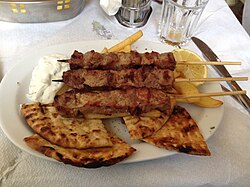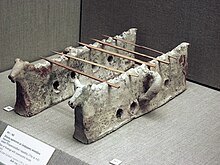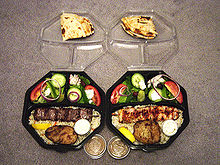Souvlaki
 Souvlaki in Athens, known there also as kalamaki | |
| Alternative names | cetsyvlaki |
|---|---|
| Type | Fast food |
| Place of origin | |
| Region or state | |
| Associated cuisine | Greek cuisine |
| Main ingredients | Various meats |
Souvlaki (
Etymology
The word souvlaki is a
").History

In
In Mycenaean Greece, "souvlaki trays" were discovered in Gla, Mycenae, and Pylos.[3] The "souvlaki trays" (or portable grills) used by the Mycenaean Greeks were rectangular ceramic pans that sat underneath skewers of meat.[3] It is not clear whether these trays would have been placed directly over a fire or if the pans would have held hot coals like a portable barbecue pit.[3][6] Spit supports appear to "continue in use into the Early Iron Age at Nichoria."[3] In Greek literature, Homer in the Iliad (1.465) mentions pieces of meat roasted on spits (ὀβελός); this is also mentioned in the works of Aristophanes,[7] Xenophon,[8] Aristotle,[9] and others.[10][11] In Classical Greece, a small spit or skewer was known as ὀβελίσκος (obeliskos),[12] and Aristophanes mentions such skewers being used to roast thrushes.[13]
In the Byzantine Empire, the Greek author of the Prodromic Poems (4.231) mentions "the hot meat shops" of Constantinople providing clients with spit-roasting meat slices similar to souvlaki known as psenasis souglitarea.[14]
Modern-day souvlaki was described by Gustave Flaubert, a French traveler, who observed Greeks "grilling pieces of meat on a bamboo stick" during his visit to the Boeotian countryside of southern Central Greece in 1850.[15] However, modern-day souvlaki was not widely distributed in Greece until after World War II.[15] Souvlaki skewers served as fast food started to be sold widely in the 1960s, after being introduced by vendors from Boeotia.[15] The first known use of the word souvlaki in English was in 1942.[16]
Variations



Kalamaki
Kalamaki (καλαμάκι meaning "
Souvlaki-merida
Merída (μερίδα) means portion in Greek. While souvlaki is eaten plain as a fast food, it is also served as a full plate, served with fried potatoes, vegetables, sauce, and quartered pita bread. Usually it consists of the ingredients of a souvlaki-pita (see below) laid out on a plate. Lamb is mostly used, but others can be used, such as ox.
Souvlaki pita
Souvlaki-
In some areas, when chicken is used instead of pork, tzatziki and onions are replaced with a special yellow mustard sauce and
Corfu
In Corfu, a special tomato sauce is added to souvlaki, plainly called "red sauce" (κόκκινη σάλτσα).
Cyprus
In Cyprus, souvlaki can refer both to the small chunks of meat on a skewer, and to the dish. It is made with a large pita that has a pocket-style opening. Into this is placed the meat (traditionally lamb or pork, more recently sheftalia or chicken), which in Cypriot souvlaki is cut into slightly larger chunks. Tomatoes, cucumbers and shredded white cabbage are the usual salad additions. Onion, parsley, and pickled green chili peppers are common accompaniments, as are yogurt and tzatziki. Cut lemons are always included with souvlaki, as they are with all grilled meats in Cyprus. Lettuce is not traditional and is seldom used in souvlaki outside of tourist resorts.[citation needed]
References
Citations
- Λεξικό της Νεας Ελληνικής Γλώσσας, s.v.; Andriotis et al., Λεξικό της Κοινής Νεοελληνικής, s.v. σουβλάκι, s.v. σούβλα
- ^ Sophocles 2004, p. 1000.
- ^ a b c d e Hruby 2017, "Souvlaki trays", pp. 23–25.
- ^ Eptakili, Tassoula (9 October 2015). "Prehistoric Gastronomy: Dietary habits of a long-lost era". Greece Is. Retrieved 21 February 2016.
- ^ Utilitarian terracotta object, Museum of Cycladic Culture, Akrotiri excavation artifacts, Santorini, Cyclades, Hellas (Greece).
- ^ Gannon, Megan (8 January 2014). "Ancient Greeks Used Portable Grills at Their Picnics". Live Science. Retrieved 5 February 2020.
- ^ Aristophanes. Acharnians 1007, Clouds 178, Wasps 354, Birds 388, 672.
- ^ Xenophon. Hellenica, HG3.3.7.
- ^ Aristotle. Politics, 1324b19.
- ^ Homer. Iliad, 1.465.
- ^ Wright 1999, p. 333.
- ^ Liddell & Scott 1940: ὀβελίσκος, diminutive of ὀβελός (obelos).
- ^ Aristophanes. Acharnians, 1007.
- ^ Dalby 2010, pp. 70, 225.
- ^ a b c Matalas & Yannakoulia 2000, p. 6 including footnote 8.
- ^ "Souvlaki". Merriam-Webster. Retrieved 5 February 2020.
General and cited sources
- Bonanos, Christopher (2005). Gods, Heroes, and Philosophers: A Celebration of all Things Greek. New York: Citadel Press (Kensington Publishing Corp.). ISBN 9780806536811.
- Dalby, Andrew (2010). Tastes of Byzantium. London and New York: I.B. Tauris & Co. Limited. ISBN 9781848851658.
- Gold, David L. (2009). Studies in Etymology and Etiology With Emphasis on Germanic, Jewish, Romance and Slavic Languages. San Vincente de Raspeig: Universidad de Alicante. ISBN 9788479085179.
- Hruby, Julie (2017). "3 Finding haute cuisine: Identifying shifts in food styles from cooking vessels". In Hruby, Julie; Trusty, Debra (eds.). From Cooking Vessels to Cultural Practices in the Late Bronze Age Aegean. Oxford and Philadelphia: Oxbow Books. pp. 15–26. ISBN 9781785706325.
- Liddell, Henry George; Scott, Robert (1940). A Greek-English Lexicon. Oxford: Clarendon Press.
- Matalas, Antonia-Leda; Yannakoulia, Mary (2000). "Greek Street Food Vending: An Old Habit Turned New". In ISBN 9783805569279.
- Sophocles, Evangelinus Apostolides (2004) [1888]. Greek Lexicon of the Roman and Byzantine Periods (From B. C. 146 to A. D. 1100). Athens: Pelekanos Books. ISBN 9789604007257.
- Wright, Clifford A. (1999). A Mediterranean Feast. New York: William Morrow. ISBN 9780688153052.
External links
- "How to Cook Like a Mycenaean". Archaeology Magazine. Archaeological Institute of America. 9 January 2014. Retrieved 5 February 2020.

